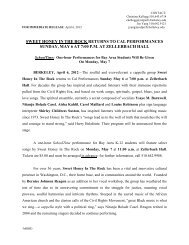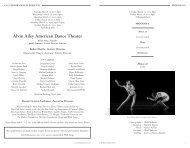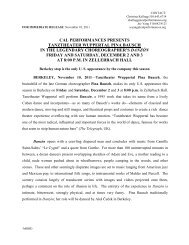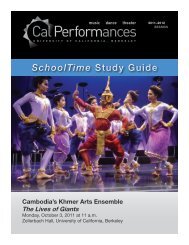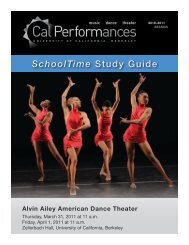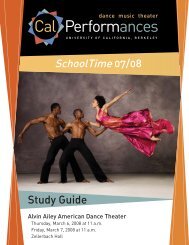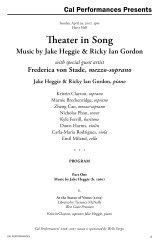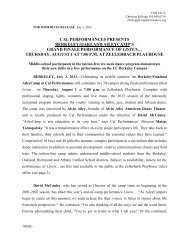Alvin Ailey American Dance Theater Study Guide 0809.indd - Cal ...
Alvin Ailey American Dance Theater Study Guide 0809.indd - Cal ...
Alvin Ailey American Dance Theater Study Guide 0809.indd - Cal ...
You also want an ePaper? Increase the reach of your titles
YUMPU automatically turns print PDFs into web optimized ePapers that Google loves.
2008-2009 SeasonSchoolTime <strong>Study</strong> <strong>Guide</strong><strong>Alvin</strong> <strong>Ailey</strong> <strong>American</strong> <strong>Dance</strong> <strong>Theater</strong>Photo: JUDITH JAMISON1976 Photograph © Jack MitchellThursday, March 5 and Friday, March 6, 2009 at 11 a.m.Zellerbach Hall, University of <strong>Cal</strong>ifornia, Berkeley
Table of Contents1. <strong>Theater</strong> Etiquette 12. Student Resource Sheet 23. About the Performance & Artists 44. About the Art Form 85. About the Music 106. Learning Activities 137. Glossary 178. <strong>Cal</strong>ifornia State Standards 18About SchoolTime 19IV | SchoolTime <strong>Alvin</strong> <strong>Ailey</strong> <strong>American</strong> <strong>Dance</strong> <strong>Theater</strong>
1 <strong>Theater</strong> EtiquetteBe prepared and arrive early. Ideally you should arrive at the theater 30 to 45minutes before the show. Allow for travel time and parking, and plan to be in your seats atleast 15 minutes before the performance begins.Be aware and remain quiet. The theater is a “live” space—you can hear theperformers easily, but they can also hear you, and you can hear other audience members,too! Even the smallest sounds, like rustling papers and whispering, can be heard throughoutthe theater, so it’s best to stay quiet so that everyone can enjoy the performance withoutdistractions. The international sign for “Quiet Please” is to silently raise your index finger toyour lips.Show appreciation by applauding. Applause is the best way to show yourenthusiasm and appreciation. Performers return their appreciation for your attention bybowing to the audience at the end of the show. It is always appropriate to applaud at the endof a performance, and it is customary to continue clapping until the curtain comes down orthe house lights come up.Participate by responding to the action onstage. Sometimes during aperformance, you may respond by laughing, crying or sighing. By all means, feel free to doso! Appreciation can be shown in many different ways, depending upon the art form. Forinstance, an audience attending a string quartet performance will sit very quietly, while theaudience at a gospel concert may be inspired to participate by clapping and shouting.Concentrate to help the performers. These artists use concentration to focustheir energy while on stage. If the audience is focused while watching the performance, theyfeel supported and are able to do their best work. They can feel that you are with them!Please note: Backpacks and lunches are not permitted in the theater. Bags will beprovided for lobby storage in the event that you bring these with you. There is absolutelyno food or drink permitted in the seating areas. Recording devices of any kind, includingcameras, cannot be used during performances. Please remember to turn off your cellphone.SchoolTime <strong>Alvin</strong> <strong>Ailey</strong> <strong>American</strong> <strong>Dance</strong> <strong>Theater</strong> | 1
2 Student Resource SheetQuestions to Think About During the Performance• What does the <strong>Ailey</strong> company offer besides performances?• What influenced <strong>Ailey</strong>’s choreography?• What was the role of spirituals?Adapted from The KennedyCenter’s Cuesheet.<strong>Alvin</strong> <strong>Ailey</strong> <strong>American</strong> <strong>Dance</strong> <strong>Theater</strong>2 |What You’ll SeeThe <strong>Alvin</strong> <strong>Ailey</strong> <strong>American</strong> <strong>Dance</strong> <strong>Theater</strong> willperform two different SchoolTime programs.Thursday, March 5Highlights from the company’s 50thanniversary celebration, including Opus McShann,Road of the Pheobe Snow, Three Black Kings andRevelations (in full).Friday, March 6Excerpts from Night Creature andRevelations (in full).The company’s most popular piece,Revelations, is based on <strong>Alvin</strong> <strong>Ailey</strong>’s childhoodmemories of worshipping at his Baptist church inTexas and uses African <strong>American</strong> religious music,or spirituals. The other works showcase a rangeof modern choreography (arrangement of dancemovements) that include elements of hip-hop, jazz,Afro-Cuban rhythms and rhythm and blues.About the <strong>Alvin</strong> <strong>Ailey</strong> <strong>American</strong> <strong>Dance</strong><strong>Theater</strong>When <strong>Ailey</strong> created his dance company in1958, he wanted to make new and expressivemodern dance works that showed African-<strong>American</strong> culture and heritage. He wantedthe company’s repertory (selection of works)to be varied so he included pieces by new andestablished choreographers. In its 50-year history,the company has performed for almost 20 millionpeople worldwide, and earned a reputation as oneof the most popular <strong>American</strong> dance companies.The <strong>Alvin</strong> <strong>Ailey</strong> <strong>American</strong> <strong>Dance</strong> Center wasfounded in 1969 and today over 3,500 studentsfrom every part of the world receive trainingthere. In 1989, <strong>Ailey</strong>Camp was started. This unique
3 About the Performance & ArtistsGuiding Questions:<strong>Alvin</strong> <strong>Ailey</strong> <strong>American</strong> <strong>Dance</strong> <strong>Theater</strong>♦♦♦What are some of <strong>Alvin</strong> <strong>Ailey</strong>’s achievements?What factors inspired <strong>Alvin</strong> <strong>Ailey</strong> to create Revelations?What are some of the <strong>Ailey</strong> companies’ programs for young people?<strong>Alvin</strong> <strong>Ailey</strong> <strong>American</strong> <strong>Dance</strong> <strong>Theater</strong>JUDITH JAMISON,ARTISTIC DIRECTORMasazumi Chaya,ASSOCIATE ARTISTIC DIRECTORThursday, March 5Opus McShann (excerpts)Choreography by <strong>Alvin</strong> <strong>Ailey</strong>, 1988Music by Jay McShann and othersCostumes by Randy BarceloLighting by Timothy HunterRoad of the Phoebe Snow (excerpts)Choreography by Talley Beatty, 1959Restaged by Masazumi ChayaMusic by Duke Ellington & Billy StrayhornCostumes by Normand MaxonLighting by Chenault SpenceThree Black Kings (excerpts)Choreography by <strong>Alvin</strong> <strong>Ailey</strong>, 1976Music by Duke and Mercer EllingtonDecor by Irving Milton DukeCostumes by Normand MaxonLighting by William BurdFriday, March 6Night Creature (excerpts)Choreography by <strong>Alvin</strong> <strong>Ailey</strong>, 1974Music: Duke Ellington’s “Night Creature”Costume by Barbara ForbesLighting by Chenault SpenceRevelationsChoreography by <strong>Alvin</strong> <strong>Ailey</strong>, 1960Music: African <strong>American</strong> SpiritualsDecor and Costumes by Ves HarperCostume redesign by Barbara ForbesLighting by Nicola CernovitchRevelationsChoreography by <strong>Alvin</strong> <strong>Ailey</strong>, 1960Music: African <strong>American</strong> SpiritualsDecor and Costumes by Ves HarperCostume redesign by Barbara ForbesLighting by Nicola Cernovitch4 |
This season the <strong>Alvin</strong> <strong>Ailey</strong> <strong>American</strong><strong>Dance</strong> <strong>Theater</strong> marks its 50th anniversary,and a glorious achievement of bringingAfrican-<strong>American</strong> cultural expression andthe <strong>American</strong> modern dance tradition tothe world’s stages.Mr. <strong>Ailey</strong> founded the company in1958 and in the next 10 years he createdapproximately 20 ballets, among themRevelations (1960). He ensured thatthe company’s repertory also includedworks by dance pioneers and emergingchoreographers. Over the past 50 years,the company has produced more than 180works by 77 choreographers. Performingfor an estimated 19 million people in 48states, 68 countries and on six continents,<strong>Alvin</strong> <strong>Ailey</strong> <strong>American</strong> <strong>Dance</strong> <strong>Theater</strong> hasearned a reputation as one of the mostpopular international ambassadors of<strong>American</strong> culture.The <strong>Alvin</strong> <strong>Ailey</strong> <strong>American</strong> <strong>Dance</strong>Center was founded in 1969 with an initialenrollment of 125 students. Today, over3,500 dance students from every part ofthe world receive training there. Thisdiverse group of students contributes toa multicultural richness that is uniqueamong dance schools.The company has a long-standinginvolvement in arts education,including a unique national programcalled <strong>Ailey</strong>Camp. <strong>Ailey</strong>Camp bringsunderserved youngsters to a fullscholarshipsummer day camp thatcombines dance classes with personaldevelopment, creative writing classesand field trips. Berkeley/Oakland<strong>Ailey</strong>Camp is now in its eighth year at <strong>Cal</strong>Performances.SchoolTime <strong>Alvin</strong> <strong>Ailey</strong> <strong>American</strong> <strong>Dance</strong> <strong>Theater</strong> | 5
<strong>Alvin</strong> <strong>Ailey</strong> (1931-1989)Born in Rogers, Texas, on January5, 1931, <strong>Alvin</strong> <strong>Ailey</strong> spent his formativeyears going to Sunday School andparticipating in the Baptist Young PeoplesUnion – experiences that later inspiredRevelations.<strong>Ailey</strong> began his formal dance trainingin Los Angeles motivated by performancesof the Katherine Dunham <strong>Dance</strong> Companyand classes with Lester Horton. Horton,the founder of the first racially integrateddance company in the United States, wasa catalyst for <strong>Ailey</strong>’s career. After Horton’sdeath in 1953, <strong>Ailey</strong> became the directorof the Horton <strong>Dance</strong> <strong>Theater</strong> and began tochoreograph his own works. Soon after hebegan the <strong>Alvin</strong> <strong>Ailey</strong> <strong>American</strong> <strong>Dance</strong><strong>Theater</strong>.<strong>Alvin</strong> <strong>Ailey</strong> died onDecember 1, 1989, and with hisdeath <strong>American</strong> dance lost oneof its most luminous stars. AnnaKisselgoff of The New York Timeswrote “You didn’t need to haveknown <strong>Alvin</strong> personally tohave been touched by hishumanity, enthusiasmand exuberance and hiscourageous stand formultiracial brotherhood.”Artistic Director, Judith JamisonA native of Philadelphia , JudithJamison became a member of <strong>Alvin</strong> <strong>Ailey</strong><strong>American</strong> <strong>Dance</strong> <strong>Theater</strong> in 1965 anddanced with the company for 15 years togreat acclaim. She was appointed ArtisticDirector of <strong>Alvin</strong> <strong>Ailey</strong> <strong>American</strong> <strong>Dance</strong><strong>Theater</strong> in December 1989 at the requestof her mentor, <strong>Alvin</strong> <strong>Ailey</strong>. When namedArtistic Director of the Company, she said“I view this appointment as the course totake to continue my vision and keep Mr.<strong>Ailey</strong>’s vision alive.”Today, Jamison presides over arenewed organization, artistically andfiscally energized. Following <strong>Alvin</strong><strong>Ailey</strong>’s ideals, Jamison is dedicated toasserting the prominence of the artsin our culture, spearheadinginitiatives to bring dance intothe community and programsthat introduce children to thearts. She remains committedto promoting the <strong>Ailey</strong>legacy—danceas a mediumfor honoring thepast, celebratingthe present andfearlessly reachinginto the future.6 |
Excerpts from the autobiography of <strong>Alvin</strong> <strong>Ailey</strong>The Inspiration for RevelationsRevelations began with the music. As early as Ican remember I was en thralled by the music playedand sung in the small black churches in every smallTexas town my mother and I lived in. No matterwhere we were during those nomadic years, Sundaywas always a church-going day.With profound feeling, with faith, hope, joy andsometimes sadness, the choirs, congregations,deacons, preachers, and ushers would sing blackspirituals and gospel songs. They sang and playedthe music with such fervor that even as a small childI could not only hear it but almost see it. I tried toput all of that feeling into Revelations.Creating the <strong>Dance</strong>The opening part of Revelations was abouttrying to get up out of the ground. The costumesand set would be colored brown and earth color,for coming out of the earth, for going into the earth.The second part was something that was very closeto me—the baptismal, the purification rite. Itscolors would be white and pale blue. Then therewould be the section surrounding the gospel church,the holy rollers, and all that church happiness. Itscolors would be earth tones, yellow, and black.The first version of Revelations was quitelong, an hour and five minutes, and it had threesections. The first was called “Pilgrim of Sorrow.”I took all the songs dealing with black people’ssorrow and put them in this section. The middlesection was to be wading in the water. Songs suchas “Honor, Honor” had all the extraordinary words.I was moved by what spirituals say as words, asmetaphors. So I found these short songs for themiddle section.There were quite a few songs for the lastsection, “Move, Members, Move.” The whole balletwas a gigantic suite of spirituals. I poured in justabout everything, every beautiful spiritual I had everheard.SchoolTime <strong>Alvin</strong> <strong>Ailey</strong> <strong>American</strong> <strong>Dance</strong> <strong>Theater</strong> | 7
5 About the Art FormGuiding Questions:♦♦♦What types of dance influenced <strong>Alvin</strong> <strong>Ailey</strong>’s choreography?What qualities are special in the Horton technique?What are the characteristic elements of modern dance?Modern <strong>Dance</strong>Created in America about 100 yearsago, modern dance is a much youngerart form than ballet or folk dance. Balletbegan in France in the 1500s and 1600s,and for almost 500 years ballet dancershave performed classical ballet’s traditionalsteps and movements. Ballet choreographyemphasizes symmetry and repeatingpatterns, and dancers hold their bodiesstraight and try to give the illusion ofweightlessness.Modern dance developed in the 20thcentury, primarily in the United States andGermany, as a rebellious response to thetraditional rigidity of classical ballet. Knownfor its invention, independent, avant-gardeattitude and “modern” sensibility, moderndance’s vocabulary pushed the boundariesset by traditional schools of dance,expanding the standardized movementsof ballet to include everyday actions likewalking, running and falling.Modern dance pioneers like IsadoraDuncan, Ruth St. Denis and Rudolf vonLaben each sought to inspire audiences to anew awareness of how the body could moveand express emotion. Each modern dancecompany has its own style and uniquemovement vocabulary according to theartistic director’s creative talents.<strong>Alvin</strong> <strong>Ailey</strong> <strong>American</strong> <strong>Dance</strong><strong>Theater</strong> performs dances by differentchoreographers, including many by itsfounder <strong>Alvin</strong> <strong>Ailey</strong>. <strong>Ailey</strong> developed hisunique style of choreography through hisknowledge and use of several moderndance techniques including those of LesterHorton, Martha Graham, as well as utilizingAfrican dance, ballet, jazz and the observed“pedestrian” movement of everyday people.He combined all the movements he foundmost engaging.8 |
Whatever the particulars, all dancescontain the principles of choreography:putting movements together artfullyin interesting, thought-provoking orinspiring ways. Even when there is no“story” with characters or a beginning,middle and end, dance expresses manyemotions, ideas and moods.<strong>Dance</strong> TechniquesHortonCreated by Lester Horton, this is atechnique that explores how many differentways the body can move. Horton namedthese movements “studies.” Some ofthe studies are for balance, some forstrengthening and some for working onthe swinging action of the body. A Hortondancer uses as much space as possible:turning, bending and jumping sideways,backwards and even upside-down. Theshapes created are clear and linear.The Horton technique gives a feeling ofstrength and energy.DunhamCreated by Katherine Dunham, thistechnique blends Caribbean, West Africanand African <strong>American</strong> folk patterns ofmovement and rhythms. The originaldance patterns have been preserved, butthe dances have been slightly modifiedin keeping with modern dance form. Thetechnique also employs the styles ofballet, modern dance, jazz and basic folkpatterns.GrahamA dance technique created by MarthaGraham that is based on the principle ofcontraction and release, movement thatis similar to the act of breathing, creatinga current of energy through the body. Theback appears rounded in a contraction andthe chest is lifted in a release. Movementitself is dramatic and expressive.Martha GrahamKatherine DunhamSchoolTime <strong>Alvin</strong> <strong>Ailey</strong> <strong>American</strong> <strong>Dance</strong> <strong>Theater</strong> | 9
6 About the MusicGuiding Questions:♦♦♦What are spirituals?Why were spirituals important to slaves?What are common themes in spirituals?African <strong>American</strong> SpiritualsSlave SongsWhen Africans were brought toAmerica as slaves in the 1700s and 1800s,they entered a frightening and dangerousworld. However, one thing gave slavescomfort in spite of the many hardshipsthey endured: music, especially singing.When slaves sang together, they created afeeling of community.Slaves were made to convert toChristianity and spirituals were born fromthe mingling of Protestant hymns withAfrican musical traditions. The songsare easy to learn and to sing – “Michael,Row the Boat Ashore,” “Swing Low, SweetChariot” and “Go Down, Moses” areexamples of spirituals.of the song that repeats after each verse.That way, people could sing them withoutneeding a book. <strong>Cal</strong>l and response alsomade written music unnecessary – aleader would begin the song (the call),and everyone else would answer (theresponse).As these songs were passed onthrough oral tradition they didn’t alwayshave a set number of verses or evenspecific words. Leaders often made upverses so that the spiritual reflected thelives and emotions of the community. Asa result, every performance of a spiritualwas unique.Originally, spirituals were created fora type of religious worship called a campmeeting. People would go to the woodsand fields, camp out in tents and attendworship services for several days at atime. There they took part in the dancesand song rituals of their homeland, andsang Christian songs of faith, hope andpain. Camp meetings were a way forpeople who lived far from a church to gettogether and worship.10 |Since most of the people coming tocamp meetings could not read or write,the songs they sang had to be easy toremember. Therefore, spirituals oftenuse repetition and have a chorus—a part
The Function of SpiritualsSpirituals spread from camp meetings toplantations, becoming part of the everydaylives of slaves until the Civil War. Thesewere functional songs, meaning that theyhad a specific purpose in society. Forexample:1. WORK. Singing spirituals made workless boring and set a rhythm for repetitivework like picking or digging. Slave ownersliked this because it made the slaves moreproductive.2. WORSHIP. Even though some ownersdidn’t allow their slaves to worship on theplantation, slaves found ways to make theirown “invisible church.” At night, after theowners were asleep, the slaves would gointo the woods (their invisible church) andworship, where no one could see or hearthem. Spirituals were an important part ofthis worship.3. ENTERTAINMENT. At the end of a longday, or during time off on a Sunday, slaveswould often sing spirituals for relaxation.4. CODE SONGS. One important functionof spirituals was their use in helping slavesescape. Code songs are songs that havehidden messages. The spiritual, “DeepRiver,” for example, was sung to announcea meeting at the river:Deep riverMy home is over Jordan, yesDeep river, Lord,I want to cross over into camp groundWhen a slave had run away and themaster had discovered his absence, theother slaves on the plantation mightsing “Wade in the Water.” Slaves onneighboring plantations would hear thesong and take it up, and the runaway,wherever he was, would know that heshould take to the river so the bloodhoundswould not be able to follow his scent.Performance of SpiritualsThere are two kinds of spirituals:• Sorrow songs are sung slowly andmournfully, and told of the heavy burdenof slavery and the belief that a better daywas coming.• Jubilees are up-tempo songscelebrating victory and joy throughreference to biblical figures like Samsonor David who overcame tremendoushardships.The Music of RevelationsRevelations is a dance in threesections, each choreographedto a selection of spirituals. Thefollowing pages include the lyricsto a sampling of the music fromRevelations.1. Pilgrim of Sorrow“I Been ‘Buked”“Didn’t My Lord Deliver Daniel”“Fix Me, Jesus”2. Take Me to the Water“Wade in the Water”“A Man Went Down to the River”“I Want to Be Ready”3. Move Members Move“Sinner Man”“The Day Is Past and Gone”“You May Run On”“Rocka-My-Soul”SchoolTime <strong>Alvin</strong> <strong>Ailey</strong> <strong>American</strong> <strong>Dance</strong> <strong>Theater</strong> | 11
Section 1: Pilgrim ofSorrowI’ve Been ‘BukedI’ve been ‘buked an’ I’ve been scorned, Yes,I’ve been ‘buked an’ I’ve been scorned,ChildrenI’ve been ‘buked an’ I’ve been scorned,I’ve been talked about sho’s you’ born.Dere is trouble all over dis worl’, Yes,Dere is trouble all over dis worl’, Children.Dere is trouble all over dis worl’Dere is trouble all over dis worl’Ain’ gwine lay my ‘ligion down, No,Ain’ gwine lay my ‘ligion down, Children.Ain’ gwine lay my ‘ligion down,Ain’ gwine lay my ‘ligion down.I’ve been ‘buked I’ve been scorned, YesI’ve been ‘buked I’ve been scorned, Children.I’ve been ‘buked I’ve been scorned.I’ve been talked about sho’s you’ born.Fix Me JesusOh, fix me, Oh, fix me, Oh, fix me.Hm——— Hm———-Fix me, Jesus, fix me.Hm——— Oh, fix me, Oh, fix me,Oh, fix me. Fix me, Jesus, fix me.Fix me for my long, white robe.Hm——— Fix me, Jesus, fix me.Fix me for my starry crown.Hm——— Fix me, Jesus, fix me.Oh, fix me, Oh, fix me, Oh fix me.Fix me, Jesus, fix me.Hm——— Fix me, Jesus, fix me.Fix me for my dyin’ bed.Hm——— Fix me Jesus, fix me.Hm——— Fix me Jesus, fix me.Fix me for my journey home.Hm——— Fix me Jesus, fix me.Oh, fix me, Oh, fix me, Oh, fix me, Lord.Oh, fix me, Oh,Fix me, Jesus, fix me. Hm———Fix me, oh, fix me. Fix me, Jesus, fix me.Section 2: Take Me to theWaterWade in the WaterWade in the water (4x).Wade in the water, children, wade in the water.God’s a gonna trouble the water.God’s a gonna trouble that band all dressedin white.God’s gonna trouble the water.It look like the band of the Israelite.God’s gonna trouble the waterWade in the water.Wade in the water children.Wade in the water.God’s a gonna trouble the water.See that band all dressed in red.God’s gonna trouble the water.Look like the band that Moses led.God’s gonna trouble the water.Wade in the water.Wade in the water children.Wade in the water.God’s a gonna trouble the water.Didn’t my Lord deliver Danuwell (Daniel)Danuwell Danuwell?Didn’t my Lord deliver Danuwell and a whynot a every man.Man went down to the river (2x)Lord, man went down to the river.He went down there to pray.Wash his sins away.He wash all day. He wash all night.He wash ‘til his hand were sore. He washall day.He wash all night ‘til he couldn’t wash em nomore.Man went down to the river. He went downthere to pray.Wash his sins away.Wade in the water. Wade in the water,Children wade in the water.God’s a gonna trouble the water (x3)I Wanna Be ReadyI wanna be ready, I wanna be ready, I wannabe ready,Lord, ready to put on my long white robe.Lord, I wanna be ready, I wanna be ready, Iwanna be ready,Lord, ready to put on my long white robe.I would not be a sinner, I’ll tell you the reasonwhy,‘Cause if my Lord should call on me,Lord, I wouldn’t be ready to die.I wanna be ready, I wanna be ready, I wannabe ready.Lord, ready to put on my long white robe.Lord, I wanna be ready, I wanna be ready, Iwanna be ready.Lord, ready to put on my long white robe.I would not be a gambler, I’ll tell you thereason why.‘Cause if my Lord should call on me,Lord, I wouldn’t be ready to die.I wanna be ready, I wanna be ready, Lord, Iwanna be ready,Lord, ready to put on my long white robe,Be ready to put on my long white robe,Jus’ ready to put on my long white robe.Section 3: Move,Members, MoveThe Day Is Past and GoneThe day is past and gone.The evening shades appear.Oh may we all remember well that the nightof death draws nigh.You May Run OnYou may run on for a long time. Run on for along time.You may run on for a long time.Let me tell you a God a mighty gonna cut youdown.Go tell that long-tongued liar, go tell thatmidnight rider.Tell the gambler, rambler back-biter.Tell him God a might gonna cut him down.My head got wet with the midnight dew.The mornin’ star was a witness too,I never shall forget that day when Jesuswashed my sins away.One day, one day, I was walkin’ along heard avoice and saw no one.Voice I heard it sound so sweet made his loverun down to my feet.Go tell that long-tongued liar, go tell thatmidnight rider.Tell the gambler, rambler back-biter.Tell him God a might gonna cut him down.You read about Samson from his birth,Strongest man whoever lived on earth.He lived way back in ancient time.Died and went to heaven in due time.Delilah fooled Samson. Don’t you know theHoly Bible tells you so.She came to Samson on her knees said,Tell me where your strength lies if you please.Delilah she looked so fair,Samson said, my strength lies in my hair.She shaved his head just as clean as yourhand,Samson got weak as any other man.Go tell that long tongued liar, go tell thatmidnight rider.Tell the rambler, gambler back biter.Tell him God a mighty gonna cut him down.A for Adam man was named placed in thegarden by God’s command.God saw Adam in a lonely state.Put him to sleep and made him a mate.Now Adam bein’ the father of the human race,Broke God’s law and tried to hide his face.In the cool of the evenin’ my Lord came down,Looked at Adam and began to frown.Adam! Adam! Where are you now?You must earn your bread by the sweat of yourbrow.Go tell that long tongued liar. Go tell thatmidnight rider.Tell the rambler, gambler back biterTell him God a mighty gonna cut him down.Some people go to church for to signify,Tryin’ to make a date with the neighbor’s wife,But neighbor, let me tell you,Just as sure as you’re born you better leavethat woman,Better leave her alone, ‘cause one of thesedays,Better mark my words, you’ll think yourneighbor has gone to work,You walk right up and knock on the door,That’s all brother you’ll knock no more.Go tell, tell that long tongued liar. Go tell thatmidnight riderTell the gambler, rambler back biter.Tell him God a mighty gonna cut him down.12 |
7 Learning ActivitiesPre-show ActivitiesAn effective way to engage your students in the performance and connect to literacy,social studies, arts and other classroom curriculum is to guide them through thesestandards-based activities before they come to the theater.<strong>Dance</strong> (Grades 3- 12)Everyday Movement1) Ask students to brainstorm a list of everyday activities, for example; stretching whenthey wake up, walking the dog, skipping rope or jumping and throwing a basketball.2) In groups of six, have students share their activity, show its movement, then have theother students repeat this movement.3) After students have shared their movements, set the movements by having studentsgo over them again, this time making sure each movement lasts for eight counts.4) Then, ask students to create an order in which to perform all six, eight-countmovements.5) Next, ask students to think of the quality they would like for each movement. Forexample, do they want to do the movement slowly and fluidly or quickly and jerkily?6) Finally, how much space should the movement take up—is the body stretched outwith the legs taking large steps, or crunched into a little ball and hardly moving?7) After repeating the movements in their chosen order several times, ask students toshare their pieces.Literacy & Visual Art (Grades 3-8)Poems inspired by spiritualsRemembering the spirituals he heard as a child, <strong>Alvin</strong> <strong>Ailey</strong> was inspired to createRevelations. Spirituals are still powerful today not only because of their historical and culturalsignificance, but because their messages are filled with strong human desires and emotions.1) Student Response:• Play a recording of a spiritual for the class.• Ask students to listen to the music once, just to hear it.• Play the piece again, and ask students to write words describing the emotions thesong makes them feel or think about.• Ask students to share with a partner some of the words• Repeat the song, and ask students to draw a picture inspired by the music.• After posting the drawings, have students do a “gallery walk” around the room.SchoolTime <strong>Alvin</strong> <strong>Ailey</strong> <strong>American</strong> <strong>Dance</strong> <strong>Theater</strong> | 13
• Hand out small post-it notes to students and ask them to do another “gallerywalk.” This time, ask students to suggest titles for drawings, which they can write onthe post-it note and place near the drawing.(Set ground rules about acceptable and non-acceptable titles).• After students read the suggested titles, play the song again and ask them to writedown words connected with the history and culture of spirituals that come to mindwhen they listen to the music.2) Creating a poem inspired by the spiritual• Ask students to choose up to five words from the ones they’ve written or received astitle suggestions.• Ask students to create a short poem or haiku using these words.• Share some of the poems.• Extension: In groups, have students choose a poem and create gestures, poses andeventually large movements to express words or phrases in the poem.Post-show ActivitiesReflecting on the performance allows students to use their critical thinking skills as theyanalyze and evaluate what they observe during the performance. Student reflection alsohelps teachers assess what students are taking in, and what they aren’t noticing.<strong>Dance</strong> (Grades K-12)Reflection on RevelationsImmediately after seeing the performance of Revelations, ask students to remembermovements and gestures. With the students arranged in a circle, ask each one to copy amovement they saw in the performance. Students can work in pairs, showing a movementfrom a duet. After seeing all the movements, ask students to share what they think someof these movements or gestures represent in terms of ideas or emotions. (Use the sectionMovements to Watch for in Revelations on page 16 to help with this discussion.)Class Discussion1) What do you think the dance Revelations is about? How did movement, costume, musicand lighting convey the meaning of the dance?2) <strong>Dance</strong> is the language of the body. Discuss this statement. Would you consider dancea universal language? Can you give examples of how you understand other people’sintentions and messages through their movements? How can you tell if someone is reallynervous, happy or angry? Have you seen anyone who seems frightening just from their bodylanguage? What kinds of movements are welcoming gestures?14 |
Movements to Watch for In RevelationsRevelations is a suite of dances that tells the story of a community of people throughvignettes composed of large and small groups, trios, duets and solos. Concepts such asoppression, dignity, hope and determination, and emotions like sorrow, anger, fear and joy,are embodied and expressed through human movement.Below is a list of specific dance gestures from Revelations. See if you can recognize some ofthe following moments as you watch the performance and identify the emotions or themes.As everyone has a unique frame of reference, a particular moment may say somethingdifferent to you than to other people. The dance is rich with imagery—the list here containsonly a few of them. Have your students make note of which scenes particularly stand out tothem in order to spark a class discussion following the performance.1. THE “BIRD” POSE. How many times did you see it performed as a group in “I Been’Buked?” In various sections of Revelations, a similar movement is done. Look for the “bird”pose repeated throughout the dance.2. PRAYING MOVEMENTS: Notice the number of different ways praying takes place inRevelations. Think about how it is portrayed and why and where it is done. Students canalso share through movement or drawing.3. FALLING TO THE FLOOR IN GRIEF AND DESPAIR happens in three different segments ofthe dance. When do they happen and what do you think they represent?4. RISING INTO THE AIR IN HOPE: In “Fix Me,” one woman is so overcome with despair shefaints twice, but in the end she ascends toward the sky as if on wings.5. LOOKING FOR A PLACE TO HIDE: In the section “Sinner Man,” some of the dancers tryto hide. Who do you think they represent? What feelings did you experience while watchingthe dance?6. A MAN AND A WOMAN CLEAR AWAY EVIL SPIRITS: Why do you think they are doingthis? What props do the dancers use to accomplish their task?7. THREE PEOPLE WALK INTO A RIVER: How do you know they are in water?8. A MAN CRAWLS ON THE FLOOR IN DETERMINATION: What do you notice about the wayhe moves? What else do his gestures convey?9. SEVERAL WOMEN CARRY ON STOOLS: Where are they? What are the doing? Whatemotions are they showing at this time?10. THE WOMEN PLAYFULLY CHASTISE THE MEN: What gestures do they use to do this?11. MEN CARRY THE STOOLS: Why might they do this?12. THE COMPANY IS SWEPT AWAY IN JOY: Describe how the dancers portray this emotion.SchoolTime <strong>Alvin</strong> <strong>Ailey</strong> <strong>American</strong> <strong>Dance</strong> <strong>Theater</strong> | 15
Resources<strong>Alvin</strong> <strong>Ailey</strong> <strong>American</strong> <strong>Dance</strong> <strong>Theater</strong>http://www.alvinailey.org/Books:<strong>Ailey</strong>, <strong>Alvin</strong> and A. Peter Bailey. Revelations: The Autobiography of <strong>Alvin</strong> <strong>Ailey</strong>.Secaucus, NJ: Birch Lane Press, 1995.Dunning, Jennifer. <strong>Alvin</strong> <strong>Ailey</strong>: A Life in <strong>Dance</strong>. New York, NY: DeCapo Press, 1998.Pinkney, Andrea Davis. <strong>Alvin</strong> <strong>Ailey</strong>. New York, NY: Hyperion Books for Children,1993.DVD / Video:Four by <strong>Ailey</strong> VHS. Director Thomas Grimm. <strong>Dance</strong> Horizons, 1986.Beyond the Steps: <strong>Alvin</strong> <strong>Ailey</strong> <strong>American</strong> <strong>Dance</strong> <strong>Theater</strong> DVD. Director PhilBertelsen. <strong>Dance</strong> Philm, 2006. Order at: http://www.aileyboutique.com/dvd/http://youtube.com/watch?v=gWJzSP7irwMhttp://youtube.com/watch?v=WefribGizyg&feature=relatedCD / Tape:<strong>Alvin</strong> <strong>Ailey</strong> <strong>American</strong> <strong>Dance</strong> <strong>Theater</strong>. Revelations. V2 Records 63881-27036-2,1998.Order at: http://www.aileyboutique.com/dvd/Podcasts:NPR: <strong>Alvin</strong> <strong>Ailey</strong>’s <strong>Dance</strong> Troupe at 45http://www.npr.org/templates/story/story.php?storyId=1912037Websites:<strong>Alvin</strong> <strong>Ailey</strong> at <strong>Cal</strong> Performances:http://www.calperfs.berkeley.edu/presents/season/2007/dance/aaadt.php16 |
8 GlossaryBallet: A dance form started in the royalcourts of Europe. The body is held mostlyupright and the legs are turned out fromthe hip. Ballet uses five basic positions ofthe feet. Ballet terms are always spoken inFrench.Arabesque: A ballet position where a dancerbalances on one leg, raises and extends theother leg behind them, and stretches theirarms forward.Artistic director: A person who has artisticcontrol of a company’s work. They will oftenchoose a company’s season and direct severalworks.<strong>Cal</strong>l and Response: A style of singing inwhich the melody sung by one singer isresponded to or echoed.Choreographer: A person who composesdance works.Duet: Any performance by two people.Dynamics: Variation and gradation in theintensity of a movement or musical sound.Ensemble: The united performance of anentire group.Folk <strong>Dance</strong>: A style of dance that originatesamong the common people of a particularnation or region.Movement Vocabulary: <strong>Dance</strong> movementsthat commonly appear in a choreographer’sworks.Repertoire/Repertory: The list of works thata company is prepared to perform.Repertory Company: A dance companythat performs many types of works by manydifferent choreographers.Salsa: A lively, vigorous type of contemporaryLatin <strong>American</strong> popular music that blendspredominantly Cuban rhythms with elementsof jazz, rock, and soul music.Solo: Any performance by one person.Spirituals: Religious songs created byAfrican <strong>American</strong> slaves, the lyrics are oftenbased on stories from the Bible.Symmetry: An exact matching of form andarrangement of parts on opposite sides of acentral point or axis.Tribute: A gift, payment, declaration, or otheracknowledgment of gratitude, respect, oradmiration.Vignette: A short scene or moment, as froma play.Work: A word that dancers use to refer toa dance; other words that are used in thismanner are “piece” and “ballet.”SchoolTime <strong>Alvin</strong> <strong>Ailey</strong> <strong>American</strong> <strong>Dance</strong> <strong>Theater</strong> | 17
9 <strong>Cal</strong>ifornia State StandardsMusic Grades K-121.0 Artistic PerceptionProcessing, analyzing, and responding to sensoryinformation through the language and skills uniqueto musicStudents listen to, analyze, and describe music andother aural information, using the terminology ofmusic.3.0 Historical and Cultural ContextUnderstanding the Historical Contributions andCultural Dimensions of MusicStudents analyze the role of music in past andpresent cultures throughout the world, notingcultural diversity as it relates to music, musicians,and composers.<strong>Dance</strong> Grades K-121.0 Artistic PerceptionProcessing, analyzing, and responding to sensoryinformation through the language and skills uniqueto dance4.0 Aesthetic ValuingResponding to, analyzing, and making judgmentsabout works of danceStudents critically assess and derive meaningfrom works of dance, performance of dancers, andoriginal works according to the elements of danceand aesthetic qualities.5.0 Connections, Relationships, ApplicationsConnecting and applying what is learned in dance tolearning in other art forms and subject areas and tocareersStudents apply what they learn in dance tolearning across subject areas. They developcompetencies and creative skills in problem solving,communication, and management of time andresources that contribute to lifelong learning andcareer skills. They also learn about careers in andrelated to dance.Students perceive and respond, using the elementsof dance. They demonstrate movement skills,process sensory information, and describemovement, using the vocabulary of dance.2.0 Creative ExpressionCreating, performing and participating in danceStudents apply choreographic principles, processes,and skills to create and communicate meaningthrough the improvisation, composition, andperformance of dance.3.0 Historical and Cultural ContextUnderstanding the historical contributions andcultural dimensions of danceStudents analyze the function and development ofdance in past and present cultures throughout theworld, noting human diversity as it relates to danceand dancers.18 |
About <strong>Cal</strong> Performancesand SchoolTimeThe mission of <strong>Cal</strong> Performances is to inspire, nurture and sustain a lifelongappreciation for the performing arts. <strong>Cal</strong> Performances, the performing arts presenterof the University of <strong>Cal</strong>ifornia, Berkeley, fulfills this mission by presenting, producing andcommissioning outstanding artists, both renowned and emerging, to serve the Universityand the broader public through performances and education and community programs.In 2005/06 <strong>Cal</strong> Performances celebrated 100 years on the UC Berkeley Campus.Our SchoolTime program cultivates an early appreciation for and understanding of theperforming arts amongst our youngest audiences, with hour-long, daytime performancesby the same world-class artists who perform as part of the main season. SchoolTime hasbecome an integral part of the academic year for teachers and students throughout theBay Area.<strong>Cal</strong> Performances Education and Community Programs Sponsors<strong>Cal</strong> Performances’ Education and Community Programs are supported by Above Ground Railroad Inc., Bank ofAmerica, The Barrios Trust, Earl F. and June Cheit, Shelley and Elliott Fineman, Flora Family Foundation, FremontGroup Foundation, The Robert J. and Helen H. Glaser Family Foundation, Jane Gottesman and Geoffrey Biddle, Evelyn& Walter Haas, Jr. Fund, Kathleen G. Henschel, Beth Hurwich, Kaiser Permanente, David L. Klein Jr. Foundation, CarolNusinow Kurland and Duff Kurland, Macy’s Foundation, Susan Marinoff and Thomas Schrag, Maris and Ivan Meyerson,Pacific National Bank, Kenneth and Frances Reid, Jim and Ruth Reynolds, Gail and Daniel Rubinfeld,The San FranciscoFoundation, Nancy Livingston and Fred Levin, The Shenson Foundation, Sharon and Barclay Simpson, Wells FargoFoundation, Wilsey Foundation, and The Zellerbach Family Fund.SchoolTime <strong>Alvin</strong> <strong>Ailey</strong> <strong>American</strong> <strong>Dance</strong> <strong>Theater</strong> | 19
This <strong>Cal</strong> Performances SchoolTime <strong>Study</strong> <strong>Guide</strong> was written, editedand designed by Laura Abrams, Rica Anderson, Nicole Anthony, andSandra Graham. Copyright © 2009 <strong>Cal</strong> Performances



